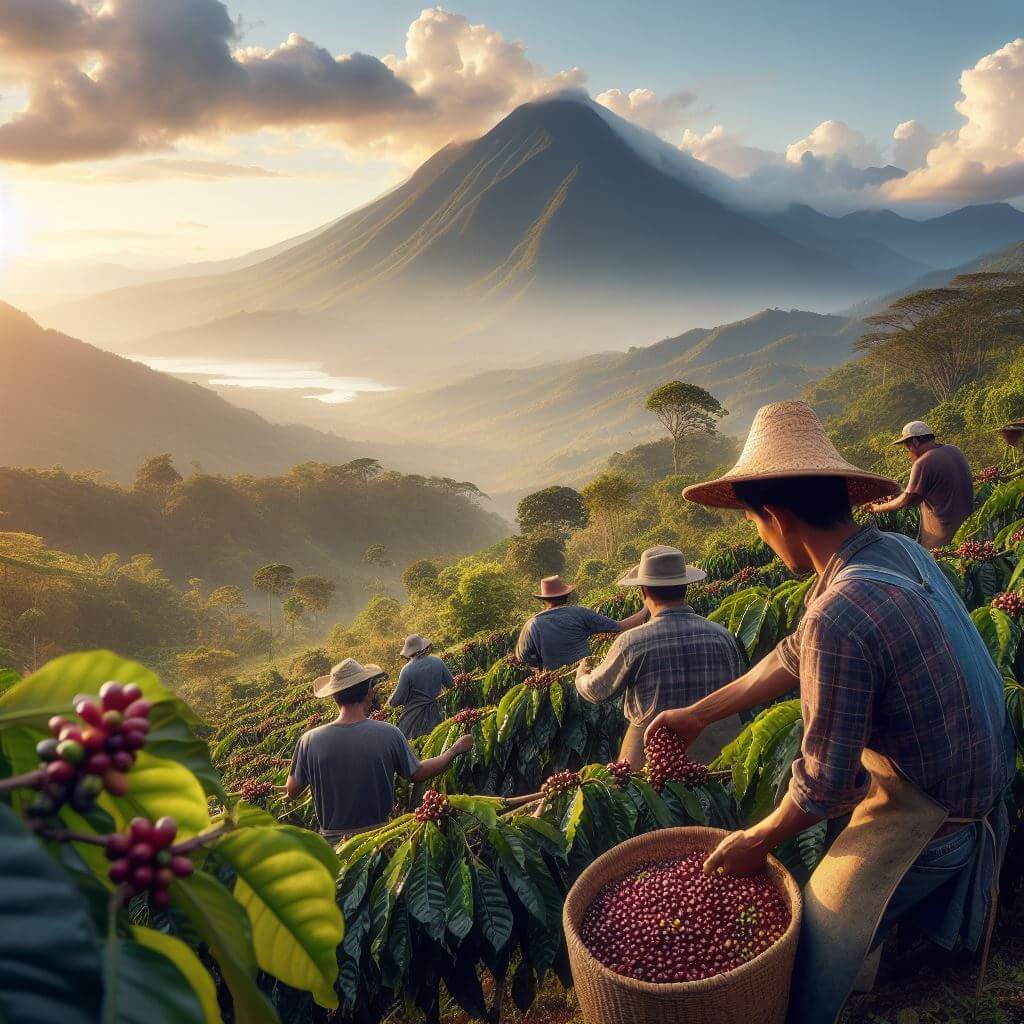
Honduras’ path to coffee production was not easy. Coffee cultivation in the country began in the mid-19th century, much later than other major coffee producers in Latin America, such as Brazil and Colombia. Initially, there was little investment and interest in developing the necessary infrastructure for large-scale production. The turbulent political environment in the country and the lack of adequate access to international markets created additional obstacles.
The first notable attempts to promote coffee as a viable industry began in the early 20th century, but it was not until the late 1970s and early 1980s that coffee began to receive serious attention. During this period, the Honduran government recognized coffee’s potential for foreign exchange and job creation. Policies aimed at increasing coffee production were introduced, including financial incentives and technical assistance to farmers. Training programs were initiated to teach farmers advanced cultivation techniques and emphasize the importance of quality control.
In 1984, a decisive event took place: the Honduran Coffee Institute (Instituto Hondureño del Café or IHCAFE) was founded. IHCAFE became the basis for the development of the coffee industry in the country. As an autonomous organization, it was tasked with supporting coffee production at various levels. This included researching best practices, providing advisory services to farmers, and promoting Honduran coffee internationally. IHCAFE has played an important role in setting quality standards and providing certifications that have helped Honduran coffee gain credibility on the world stage.
During the 1990s, the sector saw additional investment, often financed by international aid programs aimed at stimulating agricultural development. These investments allowed better roads and transport networks to be built, making it easier for farmers to get their produce to market. Improved infrastructure also facilitated the spread of technical knowledge and resources, resulting in better cultivation and processing methods.
The early 2000s witnessed a renewed focus on sustainable development. This era saw the emergence of cooperatives and farmer associations that offered a platform for sharing resources and solving problems together. These cooperatives often provided access to critical services such as credit facilities that allowed farmers to invest in better farm equipment and inputs. They also fostered a sense of community and collective effort that further drove the industry forward.
In parallel with these events, Honduras began to receive recognition for its coffee on the international stage. Honduran coffee is increasingly entering specialty coffee markets, and its unique taste characteristics are winning praise at various international coffee competitions. Regions such as Copan, Markala, and Montesillos have become particularly famous for their exceptional coffee. In 2005, the Markala region received country of origin status, a milestone that helped strengthen the reputation of Honduran coffee.
From the mid-2000s onwards, there were joint efforts aimed at implementing organic and environmentally friendly farming methods. These practices have received additional support from consumers who are increasingly aware of sustainability issues. Shade coffee growing techniques, organic fertilizers, and integrated pest management systems have become commonplace, further strengthening Honduras’ commitment to quality and environmentally responsible agriculture.
Modern Agricultural Practice
Today, Honduran coffee farmers seamlessly blend traditional methods with modern agricultural techniques to produce premium beans that stand out on the world stage. The country’s unique geography and diverse climate, especially its fertile mountainous regions, create ideal conditions for growing Arabica coffee. These areas, such as Copan, Markala, and Montecillos, have become synonymous with high-quality Honduran coffee.
One of the cornerstones of modern coffee cultivation in Honduras is the use of shade cultivation techniques. This method involves planting coffee under the canopy of trees, which provides numerous advantages. Shade from trees helps regulate temperature and humidity levels, contributing to a favorable microclimate for coffee plants. In addition, organic matter from leaf fall enriches the soil, reducing the need for chemical fertilizers. This method also supports biodiversity by creating habitats for different animal species, promoting environmental sustainability.
Organic farming practices are rapidly gaining popularity among coffee growers in Honduras. These methods eschew synthetic fertilizers and pesticides in favor of natural alternatives. Coffee farmers use compost and organic waste to fertilize their crops, increasing the organic matter content of the soil. Pest control is achieved through integrated pest management systems that use beneficial insects and natural repellents. This approach ensures that the coffee is free of harmful chemicals, meeting the growing global demand for organic produce.
Water management is another important aspect of modern coffee farming in Honduras. With the growing threat of climate change, efficient use of water has become important. Farmers are implementing various water conservation techniques such as drip irrigation and rainwater harvesting. Drip irrigation delivers water directly to plant roots, minimizing waste, while rainwater harvesting systems collect and store rainwater for use during dry periods. These strategies not only conserve water but also ensure adequate hydration of the coffee plants throughout the growth cycle.
The pursuit of quality includes careful post-harvest handling. One popular method is the wet-milling process, which involves crushing the pulp of coffee cherries to remove the outer skin and then fermenting them to remove the mucilage. Then the beans are washed and dried naturally in the sun or with the help of mechanical dryers. This method helps enhance the natural flavor of the beans, contributing to a great cup profile. In some regions, farmers prefer a dry milling process where whole cherries are dried before the beans are extracted. This can impart unique characteristics to the coffee, adding complexity and flavor.
Hand-picking is standard practice during the harvest season, which usually runs from November to March. This labor-intensive method ensures that only ripe cherries are selected, resulting in a higher-quality final product. Picking each cherry at its peak is crucial, as it directly affects the taste and aroma of the coffee. Farmers often make multiple rounds of their fields, ensuring careful and selective harvesting.
Advances in technology have also found their way to Honduran coffee farms. Many farmers now use digital tools to monitor soil and crops. These technologies provide real-time data on soil conditions, moisture levels, and plant health, allowing farmers to make informed decisions. Drones are occasionally used for aerial photography, helping to identify areas that need attention and implement best practices. The technology has also improved traceability by linking each batch of coffee to a specific farm and processing details, adding value to the specialty coffee market.
Investments in infrastructure have further strengthened the sector. Better storage facilities reduce the risk of spoilage and ensure the quality of the beans from farm to market. Modern warehouses, equipped with climate control systems, help maintain optimal conditions for coffee storage, protecting it from moisture and pests. Improved transportation networks ensure efficient transportation of coffee from remote farms to processing plants and export terminals, minimizing delays and preserving freshness.
Education and training are integral components of modern agricultural practices in Honduras. Various organizations, including IHCAFE and international NGOs, offer training programs for farmers. These programs cover a wide range of topics, from best farming practices and disease control to business skills and market trends. Farmers are being made aware of the importance of certifications such as Fair Trade and the Rainforest Alliance, which can open up new markets and secure better prices for coffee.
Challenges And Prospects For The Future
Despite significant progress, the Honduran coffee industry faces several challenges. Climate change poses a significant threat to coffee production, as changes in temperature and rainfall patterns can negatively impact yields. Problems such as pests and diseases such as coffee leaf rust are also a constant threat. The Honduran government and the private sector are working to implement adaptive measures to mitigate these risks. Investment in research and development, especially in the breeding of disease-resistant coffee varieties, is essential to ensure the future stability of the industry.
Another problem is the fluctuation of coffee prices on the world market. Price volatility can affect the income stability of smallholder farmers, making them vulnerable to economic hardship. To mitigate this impact, strategies such as diversification into the production of other crops, value-added products, and alternative sources of income are encouraged.
In terms of market penetration, Honduras continues to work to establish itself as a specialty coffee producer. Specialty coffees are beans with unique qualities and flavors that often command higher prices. By focusing on quality and branding, Honduran coffee can capture a larger share of the premium market. Participation in international coffee competitions and fairs has already brought positive results, raising the awareness and reputation of Honduran coffee around the world.
Honduras’ future prospects as a coffee producer remain promising. Thanks to continuous improvement in farming methods, better infrastructure, and government policy support, the country is well-positioned to expand its presence in the global coffee market. Collaboration between stakeholders—from farmers and cooperatives to government agencies and private companies—will be key to overcoming challenges and driving sustainable growth.

